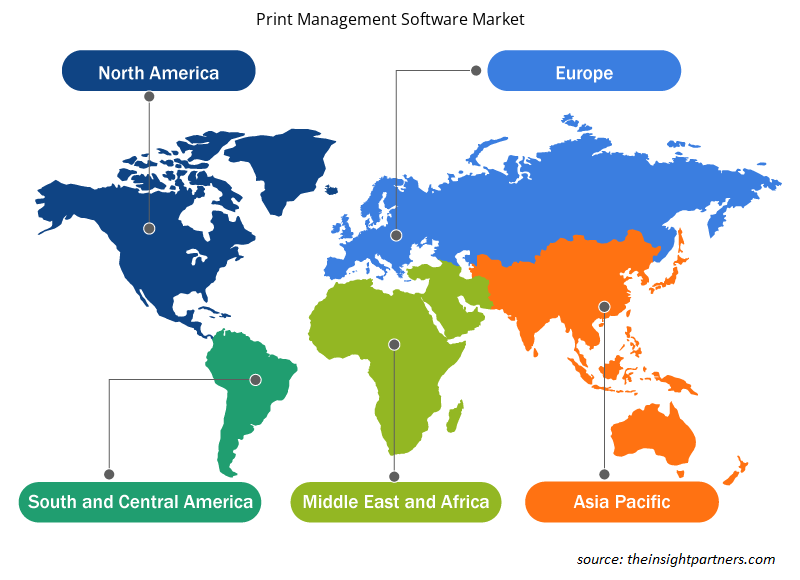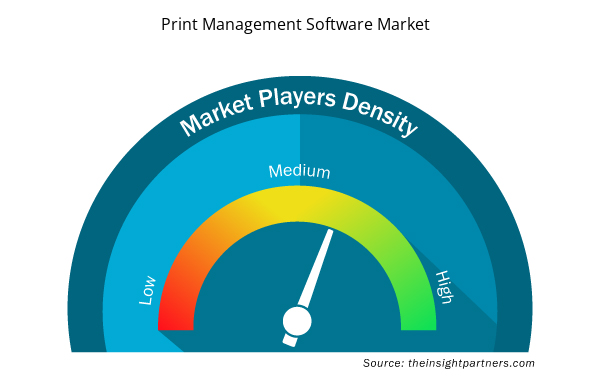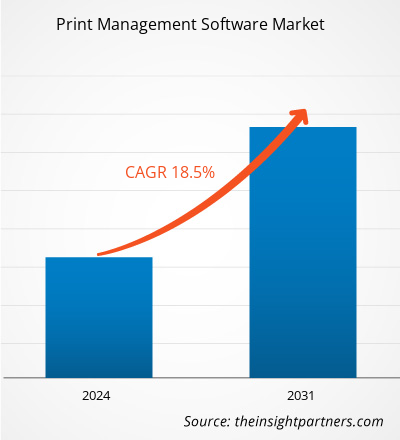印刷管理ソフトウェアの市場規模は、2023年の25億963万米ドルから2031年には97億6337万米ドルに達すると予測されています。市場は2023年から2031年の間に18.5%のCAGRを記録すると予想されています。ビッグデータとAIソリューションの採用の増加は、市場の主要なトレンドであり続けると思われます。
印刷管理ソフトウェア市場分析
印刷管理ソフトウェア市場の主な利害関係者には、ソフトウェアプロバイダー、システムインテグレーター、エンドユーザーが含まれます。印刷管理ソフトウェアプロバイダーは、組織が印刷インフラストラクチャを管理できるようにソフトウェアを開発して販売しています。主要ベンダーには、HP、Xerox、Canon、Ricoh、PaperCut、Y Softなどがあります。システムインテグレーターは、印刷管理ソフトウェア市場のエコシステムで重要な役割を果たしています。エコシステム内のさまざまなコンポーネント間の橋渡しとして機能し、シームレスで最適化された印刷環境を企業に提供します。また、多様なソリューションを統合する上で重要な役割を果たします。エンドユーザーとは、印刷管理ソフトウェアを使用して印刷インフラストラクチャを管理する組織です。エンドユーザーの規模は、中小企業から大企業までさまざまです。例: BFSI、ITおよび通信、ヘルスケア、小売。
印刷管理ソフトウェア市場の概要
印刷管理ソフトウェアは、印刷デバイスとプロセスを効果的かつ効率的に管理することを目的としています。このソフトウェアをインストールすると、単一のアプリケーション インターフェイスを介してプリンター フリート全体を監視、保守、制御するプロセスが簡単になります。配布、印刷、クイック印刷、オフセット印刷機能が容易になります。プリンター フリートに関するリアルタイム データの需要の高まりと、印刷管理ソフトウェアによるエンタープライズ印刷プロセスの管理と最適化のニーズの高まりは、今後数年間、世界的に市場の成長を支え続けると予想されるその他の要因の 1 つです。
要件に合わせてレポートをカスタマイズする
このレポートの一部、国レベルの分析、Excelデータパックなど、あらゆるレポートを無料でカスタマイズできます。また、スタートアップや大学向けのお得なオファーや割引もご利用いただけます。
- このレポートの主要な市場動向を入手してください。この無料サンプルには、市場動向から見積もりや予測に至るまでのデータ分析が含まれます。
印刷管理ソフトウェア市場の推進要因と機会
クラウドプリント管理の需要の高まり
印刷管理ソフトウェアは職場のクラウド環境の統合とサポートに役立つため、サーバーラックとローカルインフラストラクチャを備えた組織ではクラウド印刷の需要が急速に高まっています。さらに、クラウド印刷管理では、オンプレミスのインフラストラクチャであるプリントサーバーを使用する代わりに、クラウド内の印刷環境を監視、追跡、管理します。市場のいくつかの主要プレーヤーは、プライベートおよびパブリッククラウド印刷ソリューションを求める顧客向けに、幅広い印刷管理製品を提供しています。2022年6月、リコーカナダ社は、この費用対効果の高いSaaSソリューションにより、印刷インフラストラクチャを合理化し、プリントサーバーを排除し、ITの負担を軽減するRICOH Print Management Cloudの発売を発表しました。したがって、企業はオンサイトのプリントサーバーを必要とせずに、堅牢で安全な印刷を求めています。
オンデマンド印刷ソフトウェアの増加
POD ソフトウェアは、印刷機やその他の手順を正確かつ効率的に管理および最適化するのに役立ちます。また、POD ソフトウェアは主にスタンドアロン ソフトウェアとして、またはマネージド プリント施設の組み込み機能として利用できます。単一のアプリケーション インターフェイスからプリンター フリート全体を追跡、管理、制御することで、企業は印刷コストを節約できます。スキャナー、デスクトップ プリンター、マネージド コピー機により、印刷管理ソフトウェアでの統合制御が可能になります。結果として、これらの要因により、今後数年間で有利な市場成長の機会が生まれることが予想されます。
印刷管理ソフトウェア市場レポートのセグメンテーション分析
印刷管理ソフトウェア市場分析の導出に貢献した主要なセグメントは、展開、企業規模、および業界です。
- 展開に基づいて、印刷管理ソフトウェア市場はクラウドとオンプレミスに分かれています。クラウドセグメントは2023年に大きな市場シェアを占めました。
- 企業規模別に見ると、市場は大企業と中小企業に分かれています。大企業セグメントは2023年に大きな市場シェアを占めました。
- 垂直別に見ると、市場は BFSI、ヘルスケア、IT および通信、小売、その他に分類されます。
印刷管理ソフトウェアの地域別市場シェア分析
印刷管理ソフトウェア市場レポートの地理的範囲は、主に北米、アジア太平洋、ヨーロッパ、中東およびアフリカ、南米および中米の 5 つの地域に分かれています。
アジア太平洋地域の市場は、印刷管理ソフトウェアプロバイダーの増加と印刷コストの削減への重点の高まりにより、予測期間中に著しい成長を遂げると予測されています。
印刷管理ソフトウェア市場の地域別分析
予測期間を通じて印刷管理ソフトウェア市場に影響を与える地域的な傾向と要因は、Insight Partners のアナリストによって徹底的に説明されています。このセクションでは、北米、ヨーロッパ、アジア太平洋、中東およびアフリカ、南米および中米にわたる印刷管理ソフトウェア市場のセグメントと地理についても説明します。

- 印刷管理ソフトウェア市場の地域別データを入手
印刷管理ソフトウェア市場レポートの範囲
| レポート属性 | 詳細 |
|---|---|
| 2023年の市場規模 | 25億963万米ドル |
| 2031年までの市場規模 | 97億6,337万米ドル |
| 世界のCAGR(2023年~2031年) | 18.5% |
| 履歴データ | 2021-2022 |
| 予測期間 | 2024-2031 |
| 対象セグメント | 展開別
|
| 対象地域と国 | 北米
|
| 市場リーダーと主要企業プロフィール |
|
市場プレーヤーの密度:ビジネスダイナミクスへの影響を理解する
印刷管理ソフトウェア市場は、消費者の嗜好の変化、技術の進歩、製品の利点に対する認識の高まりなどの要因により、エンドユーザーの需要が高まり、急速に成長しています。需要が高まるにつれて、企業は提供内容を拡大し、消費者のニーズを満たすために革新を起こし、新たなトレンドを活用し、市場の成長をさらに促進しています。
市場プレーヤー密度とは、特定の市場または業界内で活動している企業または会社の分布を指します。これは、特定の市場スペースに、その規模または総市場価値と比較して、どれだけの競合相手 (市場プレーヤー) が存在するかを示します。
印刷管理ソフトウェア市場で事業を展開している主要企業は次のとおりです。
- ANDテクノロジーズ
- 株式会社
- キヤノン株式会社
- イーペーパー株式会社
- タングステンオートメーション株式会社
- プリンターロジック
免責事項:上記の企業は、特定の順序でランク付けされていません。

- 印刷管理ソフトウェア市場のトップキープレーヤーの概要を入手
印刷管理ソフトウェア市場のニュースと最近の動向
印刷管理ソフトウェア市場は、主要な企業出版物、協会データ、データベースなど、一次調査と二次調査後の定性的および定量的データを収集することによって評価されます。印刷管理ソフトウェア市場におけるいくつかの開発を次に示します。
- PaperCut は、Google が社内の印刷インフラを強化するために PaperCut MF を標準化したと発表しました。この発表は、Google クラウド プリントの終了を受けてのものです。このサービスにより、社内外のユーザーは、クラウド プリント サービスに接続できる機能を使用して、ネットワーク クラウド内の任意のデバイス上のクラウド プリント対応アプリケーションから任意のプリンターに印刷できるようになりました。(出典: PaperCut、プレスリリース、2022 年 7 月)
- 印刷管理ソリューションの大手サプライヤーの 1 つである ThinPrint は、高可用性印刷のための新しいアプローチを開始しました。ThinPrint LPD サービスは、ERP、EMR、CRM システムからの負荷分散を含む高可用性印刷を提供します。したがって、ThinPrint はビジネス クリティカルな停止を防ぐための重要なツールを提供します。(出典: ThinPrint、プレス リリース、2023 年 12 月)
印刷管理ソフトウェア市場レポートの対象範囲と成果物
「印刷管理ソフトウェア市場の規模と予測(2021〜2031年)」レポートでは、以下の分野をカバーする市場の詳細な分析を提供しています。
- 印刷管理ソフトウェア市場の規模と予測(対象範囲に含まれるすべての主要市場セグメントについて、世界、地域、国レベルで)
- 印刷管理ソフトウェア市場の動向、推進要因、制約、主要な機会などの市場動向
- 詳細なPEST/ポーターの5つの力とSWOT分析
- 主要な市場動向、世界および地域の枠組み、主要プレーヤー、規制、最近の市場動向を網羅した印刷管理ソフトウェア市場分析
- 市場集中、ヒートマップ分析、主要プレーヤー、印刷管理ソフトウェア市場の最近の動向を網羅した業界の状況と競争分析
- 詳細な企業プロフィール
- 過去2年間の分析、基準年、CAGRによる予測(7年間)
- PEST分析とSWOT分析
- 市場規模価値/数量 - 世界、地域、国
- 業界と競争環境
- Excel データセット



Report Coverage
Revenue forecast, Company Analysis, Industry landscape, Growth factors, and Trends

Segment Covered
This text is related
to segments covered.

Regional Scope
North America, Europe, Asia Pacific, Middle East & Africa, South & Central America

Country Scope
This text is related
to country scope.
よくある質問
The global print management software market is expected to reach US$ 9,763.37 million by 2031.
The expected CAGR of the global print management software market is 18.5 %.
APAC dominates the print management software market.
Rising demand for cloud print management and increase in print-on-demand software are the major factors that propel the global print management software market.
The rise in the adoption of big data and AI solutions is anticipated to play a significant role in the global print management software market in the coming years.
The key players holding majority shares in the global print management software market are AND Technologies, Inc.; Canon Inc.; ePaper Ltd; Tungsten Automation Corporation; PrinterLogic; PaperCut Software International Pty Ltd; Process Fusion; The Hewlett-Packard Company; ThinPrint GmbH; and Xerox Corporation.
Trends and growth analysis reports related to Technology, Media and Telecommunications : READ MORE..
The List of Companies - Print Management Software Market
- CANON INC
- TUNGSTEN AUTOMATION CORPORATION
- PAPERCUT SOFTWARE INTERNATIONAL PTY LTD
- THINPRINT GMBH
- PRINTERLOGIC
- XEROX HOLDINGS CORP
- PROCESS FUSION
- A.N.D TECHNOLOGIES, INC.
- HP INC
- EPAPER LTD
The Insight Partners performs research in 4 major stages: Data Collection & Secondary Research, Primary Research, Data Analysis and Data Triangulation & Final Review.
- Data Collection and Secondary Research:
As a market research and consulting firm operating from a decade, we have published and advised several client across the globe. First step for any study will start with an assessment of currently available data and insights from existing reports. Further, historical and current market information is collected from Investor Presentations, Annual Reports, SEC Filings, etc., and other information related to company’s performance and market positioning are gathered from Paid Databases (Factiva, Hoovers, and Reuters) and various other publications available in public domain.
Several associations trade associates, technical forums, institutes, societies and organization are accessed to gain technical as well as market related insights through their publications such as research papers, blogs and press releases related to the studies are referred to get cues about the market. Further, white papers, journals, magazines, and other news articles published in last 3 years are scrutinized and analyzed to understand the current market trends.
- Primary Research:
The primarily interview analysis comprise of data obtained from industry participants interview and answers to survey questions gathered by in-house primary team.
For primary research, interviews are conducted with industry experts/CEOs/Marketing Managers/VPs/Subject Matter Experts from both demand and supply side to get a 360-degree view of the market. The primary team conducts several interviews based on the complexity of the markets to understand the various market trends and dynamics which makes research more credible and precise.
A typical research interview fulfils the following functions:
- Provides first-hand information on the market size, market trends, growth trends, competitive landscape, and outlook
- Validates and strengthens in-house secondary research findings
- Develops the analysis team’s expertise and market understanding
Primary research involves email interactions and telephone interviews for each market, category, segment, and sub-segment across geographies. The participants who typically take part in such a process include, but are not limited to:
- Industry participants: VPs, business development managers, market intelligence managers and national sales managers
- Outside experts: Valuation experts, research analysts and key opinion leaders specializing in the electronics and semiconductor industry.
Below is the breakup of our primary respondents by company, designation, and region:

Once we receive the confirmation from primary research sources or primary respondents, we finalize the base year market estimation and forecast the data as per the macroeconomic and microeconomic factors assessed during data collection.
- Data Analysis:
Once data is validated through both secondary as well as primary respondents, we finalize the market estimations by hypothesis formulation and factor analysis at regional and country level.
- Macro-Economic Factor Analysis:
We analyse macroeconomic indicators such the gross domestic product (GDP), increase in the demand for goods and services across industries, technological advancement, regional economic growth, governmental policies, the influence of COVID-19, PEST analysis, and other aspects. This analysis aids in setting benchmarks for various nations/regions and approximating market splits. Additionally, the general trend of the aforementioned components aid in determining the market's development possibilities.
- Country Level Data:
Various factors that are especially aligned to the country are taken into account to determine the market size for a certain area and country, including the presence of vendors, such as headquarters and offices, the country's GDP, demand patterns, and industry growth. To comprehend the market dynamics for the nation, a number of growth variables, inhibitors, application areas, and current market trends are researched. The aforementioned elements aid in determining the country's overall market's growth potential.
- Company Profile:
The “Table of Contents” is formulated by listing and analyzing more than 25 - 30 companies operating in the market ecosystem across geographies. However, we profile only 10 companies as a standard practice in our syndicate reports. These 10 companies comprise leading, emerging, and regional players. Nonetheless, our analysis is not restricted to the 10 listed companies, we also analyze other companies present in the market to develop a holistic view and understand the prevailing trends. The “Company Profiles” section in the report covers key facts, business description, products & services, financial information, SWOT analysis, and key developments. The financial information presented is extracted from the annual reports and official documents of the publicly listed companies. Upon collecting the information for the sections of respective companies, we verify them via various primary sources and then compile the data in respective company profiles. The company level information helps us in deriving the base number as well as in forecasting the market size.
- Developing Base Number:
Aggregation of sales statistics (2020-2022) and macro-economic factor, and other secondary and primary research insights are utilized to arrive at base number and related market shares for 2022. The data gaps are identified in this step and relevant market data is analyzed, collected from paid primary interviews or databases. On finalizing the base year market size, forecasts are developed on the basis of macro-economic, industry and market growth factors and company level analysis.
- Data Triangulation and Final Review:
The market findings and base year market size calculations are validated from supply as well as demand side. Demand side validations are based on macro-economic factor analysis and benchmarks for respective regions and countries. In case of supply side validations, revenues of major companies are estimated (in case not available) based on industry benchmark, approximate number of employees, product portfolio, and primary interviews revenues are gathered. Further revenue from target product/service segment is assessed to avoid overshooting of market statistics. In case of heavy deviations between supply and demand side values, all thes steps are repeated to achieve synchronization.
We follow an iterative model, wherein we share our research findings with Subject Matter Experts (SME’s) and Key Opinion Leaders (KOLs) until consensus view of the market is not formulated – this model negates any drastic deviation in the opinions of experts. Only validated and universally acceptable research findings are quoted in our reports.
We have important check points that we use to validate our research findings – which we call – data triangulation, where we validate the information, we generate from secondary sources with primary interviews and then we re-validate with our internal data bases and Subject matter experts. This comprehensive model enables us to deliver high quality, reliable data in shortest possible time.


 このレポートの無料サンプルを入手する
このレポートの無料サンプルを入手する